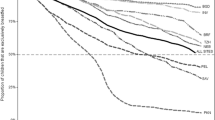Abstract
A longitudinal study of feeding practices of and morbidity in 537 infants was undertaken. Feeding practices were assessed at monthly follow-up visits. All infants were initially exclusively breastfed but their percentage dropped to 59.8% and 35.3% at the end of 3 months and 6 months respectively. Exclusively breastfed babies were three-times less likely to fall sick than artificially fed babies. Exclusive breastfeeding was also associated with significantly lowered rate of serious illnesses as shown by fewer rate of hospitalisation (0.52/100 children months vs 4.5/100 children months). Premature introduction of supplementary feeding diluted the protective effects of breastmilk.
Similar content being viewed by others
References
Baumslag N. Breastfeeding Trends and Influencing Factors.Int Child Health 1992; 3: 39–46.
Lawrence RA.Breastfeeding—A guide for the medical profession 3rd edition, CV Mosby Company, St. Louis, 1989, 1–27.
Cunningham AS, Jellife DB, Jellife EFP. Breastfeeding and health in the 1980s: A global epidemiologic review.J Pediatr 1991; 118: 659–666.
Welsh JK, Welsh JT. Anti infective properties of breastmilk.J Pediatr 1979; 91: 1–9.
Malhotra P, Prasad BG. Study of morbidity among children below five years in an urban area in Delhi.Indian J Med Res 1966; 54: 268–314.
Chitkara AJ, Gupta S. Infant feeding practices and morbidity.Indian Pediatr 1987; 24: 865–871.
Kumar V, Kumar L, Diwedi P. Morbidity related to feeding pattern in privileged urban and under privileged rural infants.Indian Pediatr 1981; 18: 743–749.
Popkin BM, Adair L, Akin JS et al. Breastfeeding and Diarrhoeal morbidity.Pediatrics 1990; 86: 874–882.
Howie PW, Forsyth JS, Ogston SA et al. Protective effect of breastfeeding against infection.BMJ 1990; 300: 11–16.
Ruiz-Palacios GM, Calva JJ, Pickering LK, Lopez-Vidal Y et al. Protection of breastfed infants against campylobacter diarrhoea by antibodies in human milk.J Pediatr 1990; 116: 707–713.
Forman MR, Graubard BI, Hoffman HJ. The Pima infant-feeding study: breastfeeding and respiratory infections during the first year of life.Int J Epid 1984; 13: 447–453.
Editorial. Lower respiratory tract infections in childhood.Lancet 1985; 1: 734–735.
Frank AL, Taber LH, Glezen WP, Kasel GL, Wells CR, Pareoles A. Breastfeedng and respiratory virus infection.Pediatrics 1984; 70: 239–245.
Author information
Authors and Affiliations
Rights and permissions
About this article
Cite this article
Kasla, R.R., Bavdekar, S.B., Joshi, S.Y. et al. Exclusive breastfeeding: Protective efficacy. Indian J Pediatr 62, 449–453 (1995). https://doi.org/10.1007/BF02755066
Issue Date:
DOI: https://doi.org/10.1007/BF02755066




